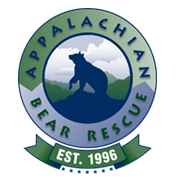- OVERVIEW OF ABR – spotlights how Appalachian Bear Rescue works from the time wildlife officers bring an orphaned cub to the facility until it is released back into the wild.
- A YEAR IN THE LIFE OF A BEAR – describes what bears are doing and what they are eating month by month through the year. The program includes seasonal implications for humans living or recreating in bear country and fascinating facts about bears.
- A CUB’S LIFE – contrasts & compares life of a cub in the wild, taught by its mother, with life of an orphaned cub cared for at ABR; how the curators minimize human contact with the cubs in their care.
- IF YOU WERE A BEAR – compares and contrasts the life of a bear with that of a human, including concepts as birth, home, education, foods, growth, family life and adulthood. The program includes fascinating facts about bears.
- AMAZING BEARS – introduces some of the truly amazing facts about black bears and the unique aspects of their lives, including reproduction, health, hibernation, strength, and intelligence.
- BE BEAR SMART, BE BEAR SAFE – a customized program to suit the needs of your group. Elements include: Bear facts and display of bear items (fur, skull, tracks, etc); Bear communication (sounds and body language); What should bears eat? “There’s a Bear!” (stories of encounters); True ABR cub stories; Problem solving for bears; and Bears of the world. A Bear buffet can be offered seasonally. Games that can be included in the program are: Bear Bingo; Foods for people and/or bears; Happy Meal food sorting; Concentration; Draw a bear: Traveling bear game; ABR logo puzzle (cut and paste); and a bear beanbag toss game. A highlight is the song “Be Bear Smart, Be Bear Safe”, with motions.
- BE BEAR AWARE – a customizable program that includes an introduction to ABR through the “Wild Side” video of a bear release, and the “Bears of the World” video, with song. A bear buffet (tasting) is provided when seasonally appropriate. Other elements can be added, as desired (see #6).
- BE A JUNIOR BEAR CURATOR FOR APPALACHIAN BEAR RESCUE – a hands on program taking students through the steps to being a curator of bear cubs. The program is an hour long and best suited for grades 2-6. Limited to 20 students.
- BEAR TALES – a selection of stories about bears – some are true, some are partly true, others are entirely fictional and include legends about bears. Some of the stories are read and others are told. The audience is challenged to decide which parts are true.
- MEET OUR NEIGHBOR (Ursus americanus) – explores the natural world of American Black Bears including development & growth, communications/language, and food sources. The presentation is typically grouped with an overview of the current cubs in the interim care of ABR and an interactive True/False exercise “Bear Encounters”.
- HOW MANY BEARS CAN LIVE IN THIS FOREST? (from Project Wild) – This activity illustrates the importance of certain elements of bear habitat on the success of a bear population, focusing on their diet and the need for water.
Children pretend to be bears as they collect cards representing seasonal foods and water that are scattered over the playing area, which can be outdoors or in a large indoor space such as a gym. Certain “bears” are assigned limitations – one has a broken leg; one is a mother who must gather enough for herself and cubs, and one’s eyes are covered with a blindfold.
After all cards are collected, the children learn what the cards represent and add up the total number of pounds of food they gathered. The number of pounds needed to survive is revealed, and each child determines whether or not they have enough to survive.
Discussion follows and children are led to answer questions that will help them to understand the concept of limiting factor in a habitat and how limiting factors can influence the population.

